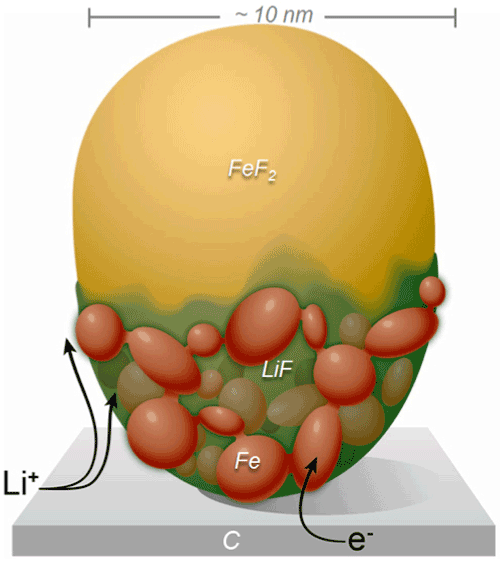Imaging techniques track lithium-ion reactions in real time
Researchers at U.S. Department of Energy’s Brookhaven National Laboratory have developed a new imaging technique that allows them to observe lithium-ion reactions in real time with nanoscale (billionths of a meter) precision. The technique uses a novel electrochemical cell and transmission electron microscopy (TEM) to track lithium reactions and precisely expose subtle changes that occur in batteries’ electrodes over time.
This nanoscale imaging will eventually enable the development of longer-lasting higher-capacity lithium-ion batteries. In addition, this development promises better consumer electronics, and the potential for large-scale, emission-free energy storage.

This diagram shows the spread of positively charged lithium ions across the custom-built FeF2 nanoparticle. The conversion reaction sweeps rapidly across the surface before proceeding more slowly in a layer-by-layer fashion through the bulk of the particle (courtesy of BNL).
The team custom-built an electromechanical cell to operate inside the TEM in which they watched the lithium reaction process as it unfolded across iron fluoride (FeF2 ) nanoparticles in a matter of seconds (see image ). The transformation than moved slowly through the bulk in a layer-by-layer fashion that split the compounds into distict regions. The team observed that the lithium-ion reaction formed trails of new molecules.
“Although many questions remain about the true mechanisms behind this conversion reaction, we now have a much more detailed understanding of electron and lithium transport in lithium-ion batteries,” said Brookhaven physicist and study coauthor Jason Graetz. “Future studies will focus on the charge reaction in an attempt to gain new insights into the degradation over time that plagues most electrodes, allowing for longer lifetimes in the next generation of energy storage devices.”
This research was published in the November issue of Nature Communications . For more information, contact Justin Eure at 631-344-2347 or Peter Genzer at 631-344-3174.
Christina Nickolas
Advertisement
Learn more about U.S. Department of Energy Brookhaven National Laboratory





